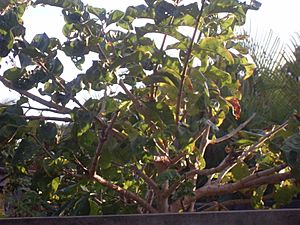Vangueria madagascariensis facts for kids
Quick facts for kids Vangueria madagascariensis |
|
|---|---|
 |
|
| Scientific classification | |
| Synonyms | |
|
The Spanish-tamarind (also called tamarind-of-the-Indies or voa vanga) is a special flowering plant from Africa. Its scientific name is Vangueria madagascariensis. It belongs to the Rubiaceae plant family, which also includes coffee plants.
This plant is well-known for its tasty, edible fruit. It is the main example for the Vangueria group of plants. A scientist named Johann Friedrich Gmelin first described it in 1791.
Discovering the Spanish-Tamarind Fruit
The Vangueria madagascariensis plant grows large, orange fruits. These fruits are safe to eat and are often enjoyed by people living in the areas where the plant grows. They are a popular local food source.
Where the Spanish-Tamarind Grows Naturally
The Vangueria madagascariensis plant is originally from many parts of Africa. You can find it growing naturally in countries like:
- Angola
- Benin
- Cameroon
- Central African Republic
- Democratic Republic of the Congo
- Ethiopia
- Ghana
- Kenya
- Madagascar
- Malawi
- Mali
- Mozambique
- Nigeria
- South Africa (in areas like KwaZulu-Natal and Transvaal)
- Sudan
- Eswatini
- Tanzania (including the Zanzibar Archipelago)
- Uganda
This wide distribution shows how well the plant can grow in different African environments.
See also
 In Spanish: Voavanga de Madagascar para niños
In Spanish: Voavanga de Madagascar para niños

